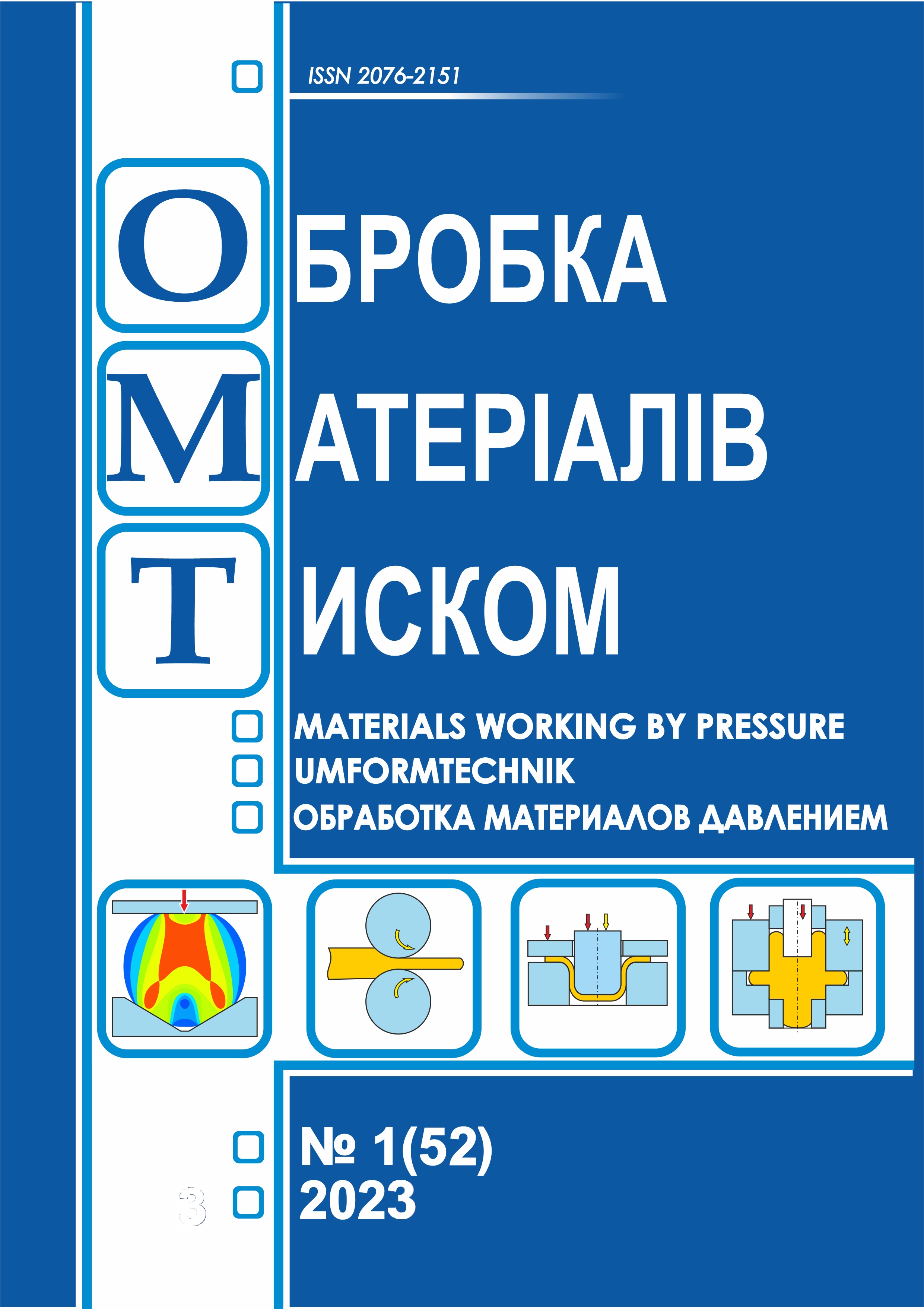Study of deformation method of hollow workpieces with bottom by dies with chamfer
DOI:
https://doi.org/10.37142/2076-2151/2023-1(52)71Keywords:
deformation, workpiece, drawing, cylinder, conical projections, mandrel, hole closingAbstract
Markov O., Stankov V., Panov V., Zinskyi V. Study of deformation method of hollow workpieces with bottom by dies with chamfer.
The paper proposes and investigates a new method for pulling blanks with a tool with bevels. The blanks were pulled by cut-out heads with cut-out angles α = 90°, 115°, 140°, cut-out bevel angles β = 10°, 20°, 30°, and the length of the horizontal flange of the deforming part (determining the feed rate) a = 100.0 mm. The degree of blank deformation was 20%, 40% and 60%. The general regularity for the investigated forging schemes is that when broached hollow billets with a decoction diameter d0/D = 0.3, the aversion is forged with a reduction of more than 40%. The results obtained show that the initial diameter of the workpiece hole has a predominant effect on the forging. However, the intensity of forging the decoction decreases with an increase in the degree of reduction of the workpiece. The general pattern for the studied forging schemes is that the intensity of prevention forging is the same at different reductions for constant ratios of the workpiece dimensions. When feeds are more than 0.2D, there is no qualitative and quantitative change in the dependence of the change in the degree and intensity of forging prevention. The recommended feed should be in the range (0.1...0.2)D. After carrying out a theoretical study, studying the deformed state of the workpiece metal and the cylinder hole forging mechanism, the most effective scheme was chosen, in which the cut-out heads had a cut-out of 115° and a width of the deforming part of 0.1D, geometric parameters d0/D = 0.8. In this scheme, during broaching, the metal flow occurred along the axis, which contributes to the continuation of forging and not complete forging of repulsion.
References
Kalchenko P.P., Markov O.E. New technological processes for forging large press forgings: monograph. Kramatorsk: DSEA. 2014. 100 p. ISBN 978-966-379-692-5. (in Russian).
Markov O.E., Aliiev I.S. Resource-saving technological processes for forging large shafts and plates: monograph. Kramatorsk: DSEA. 2012. 324 p. ISBN 978-966-379-583-6. (in Russian).
Rostovshchikov V.A. Technology and equipment for forming long hollow forgings by hot radial compression. Forging and stamping production. 1987. 6, pp. 10–13. (in Russian).
Rotational forging of hollow cylindrical blanks: dis. ...cand. tech. Sciences:05.03.05. Golyshev Igor Vladimirovich. Tula, TSU. 2008. 139 p. (in Russian).
Kargin B.S., Kotova E.S. Comparison of productivity when drawing hollow forgings on a mandrel using combined and cut-out dies. Bulletin of the Azov State Technical University. Ser. :Technical sciences. 2013. 27, pp. 49–52. (in Russian).
Pat. 86881 Ukraine, B 21 J 5/00. Method of soaking empty cylinders from the bottom. Markov O.E., Markova M.O. No. u201309697; application 05.08.13; publ. 01.10.14. Bull. No. 1. (in Ukrainian).
Markov O.E. Deformed state when pulling shortened ingots with beveled strikers. Scientific bulletin of the DSEA: collection. scientific works. Kramatorsk 2013. 2 (12E), pp. 70–78. URL: http://www.dgma.donetsk.ua/science_public/science_vesnik/№2(12E)_2013/article/12.pdf (in Russian).
Markova M.A., Nedodai R.S., Sharun A.O., Chueva K.L. Forging schemes for large forgings with intense plastic deformations. Proceedings of the XII International Scientific and Technical Conference “Importance of Mechanical Engineering. Problems and prospects for development.” 23–24 June 2014. Kramatorsk: DSEA. 2014, pp. 61. ISBN 978-966-379-640-6. (in Russian).
Markova M.A. Study of the deformed state of the workpiece when drawing hollow forgings without a mandrel using beveled strikers. Scientific Bulletin of the DSEA: collection. scientific works. Kramatorsk: DSEA. 2014. 3 (15E), pp. 75–82. (in Russian).
Markova M.A., Rizak P.I. Shaping of hollow forgings in the process of broaching without mandrels with beveled strikers. Materials Working by Pressure. Kramatorsk: DSEA. 2014. 3 (36), pp. 35-40. (in Russian).

